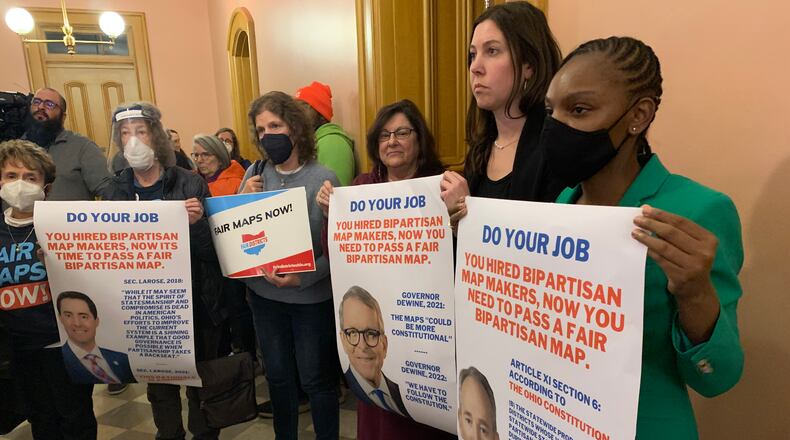Here’s the latest news on the primary and redistricting:
- On Monday night, hours before the court-imposed midnight deadline to pass a fourth set of Statehouse districts, Republican members of the commission chose not to go with maps drawn in public by two independent consultants. Instead, Republicans tweaked versions of their own third set of maps (which were previously ruled unconstitutional by the Ohio Supreme Court) and passed their maps Monday night in a 4-3 vote. The two Democrats voted against the proposal, along with Republican Ohio Auditor Keith Faber. Faber had voted against the related proposal that passed on Feb. 24, citing issues with district compactness. The maps now go back to the Ohio Supreme Court.
- This move brought strong rebukes from Democrats and voting rights activists Tuesday who said the maps were drawn in secret, do not reflect the statewide preferences of Ohio voters and are unconstitutional.
- Republicans said the mapmakers did not produce maps in time for the commission to review, amend and pass before the deadline. Republican commission members also said they wanted maps that were more compact and less frequently split municipalities.
- Republicans say their latest maps conform to the Ohio Constitution’s proportionality standard and lean 54% Republican and 46% Democratic. Opponents disagree.
- On Tuesday, the Ohio Supreme Court gave litigants challenging the latest Ohio congressional district maps 25 days to present their arguments. Democrats and voting rights group had hoped the the state’s high court would rule on the maps before early voting starts on April 5.
- A federal court could step in about the primary on Wednesday as part of an ongoing lawsuit from Republican activists asking the court to impose the Ohio General Assembly district maps that the Ohio Supreme court rejected last month. The court could take several actions, including instating the third or fourth round of Statehouse maps or moving the primary. Or they could take no action.
- A Democrat-sponsored bill to delay the primary election set for May 3 to June 28 moved to committee on Tuesday. But Republicans, including Ohio Senate President Matt Huffman, continue to oppose delaying the primary.
Background on redistricting
In 2015 and 2018, Ohioans voted in a landslide to add amendments to the Ohio Constitution requiring a bipartisan process for drawing congressional and Ohio General Assembly voting districts.
Mark Caleb Smith, a political science professor at Cedarville University, said much of the difficulty in redistricting stems from a simple fact: This is the first time the process has worked in this way. And both parties are trying to squeeze as much benefit out of it as possible, he said.
“Democrats are hoping the Ohio Supreme Court will continue to hold the majority’s feet to the fire, and require a bipartisan map as a result of the constitutional amendments,” Smith said. “Republicans are trying to secure maps that benefit them as much as possible, and they hope by making small, incremental changes, they can get through the process with their state and federal legislative majorities in place.”
The Ohio Redistricting Commission is made up of five Republicans and two Democrats. The Republican members are Gov. Mike DeWine, Speaker of the House Bob Cupp, Senate President Matt Huffman, Auditor Keith Faber and Secretary of State Frank LaRose. The Democrats are state Sen. Vernon Sykes and Minority Leader C. Allison Russo.
What’s being said about the latest General Assembly maps
“Here we are again,” commission co-chair Sykes said Monday during the commission hearing, “doing the same thing even though the court has gone out of its way to specify how to prevent us from getting in this situation again. And you have just hijacked that whole process in trying to force feed us again with the same disrespect for the public.”
Ohio Democratic Party Chair Elizabeth Walters said Tuesday Republican members of the commission have again betrayed their oath to the Ohio Constitution.
“And the price tag for Ohioans goes up as they insist on pushing GOP-gerrymandered maps rather than do the jobs they were elected to do,” she said. “Today’s latest political stunt will create even more election chaos for our state and cost Ohioans millions of dollars. It didn’t have to be this way, all Republicans had to do was their jobs.”
Common Cause Ohio, a pro-democracy group, issued a statement calling the Republicans’ maps clearly unconstitutional. They pointed out the Republicans passed maps at around 10:18 p.m. Monday and the independent mapmaker finished a draft at around 10:25 p.m.
“The betrayal and raw political bloodthirstiness of the Republican commissioners’ action was brought into even sharper focus by how profoundly it contrasted with the mapmaking process Ohioans had experienced during the previous few days,” the statement says.
Hired independent mapmakers, a Democrat and a Republican, worked for five days under the watch of a live camera.
John Fortney, spokesman for the Ohio Senate Majority Caucus, said groups like Common Cause aren’t advocates for voters.
“They simply want the courts to give them what voters won’t,” he said. “Far left special interest groups directed by Eric Holder’s NDRC have undermined the constitution and created a constitutional crisis through a sue until its blue strategy.”
Dan Tierney, a spokesman for DeWine, said the maps proposed by the independent consultants and those passed by Republicans met the constitutional proportionality requirement. He said DeWine favored the latter in part because it also met the constitutional requirement to create compact districts.
Nancy Martorano Miller, a professor of political science at the University of Dayton, said the maps passed Monday are very similar to the last ones they passed.
“Part of Auditor Faber’s rationale for voting ‘no’ was that he believed that they don’t differ enough from the previous version passed — he thinks odds are the Ohio Supreme Court will reject them again,” she said.
Could the federal court step in?
As for the federal lawsuit moving forward Wednesday, Smith at Cedarville said the GOP is looking for other methods to resolve the impasse in their favor.
“They are hoping for the federal court to forcibly implement an earlier map that would be better for the GOP,” Smith said.
Miller agrees.
“They are hoping the federal court will move their case forward and rule that the May primary go forward with the last set of maps passed and that challenges could resume with 2022 in mind,” she said.
In Secretary of State Frank LaRose’s filing with the court on Monday, he wrote: “The secretary respectfully requests that if the court ultimately decides to grant plaintiffs the relief they seek, i.e., the use of the Third Plan for Ohio’s 2022 primary election, that the court simultaneously consider moving the date of the unified primary election to at least May 24, 2022, or shortly thereafter.”
About the Author

